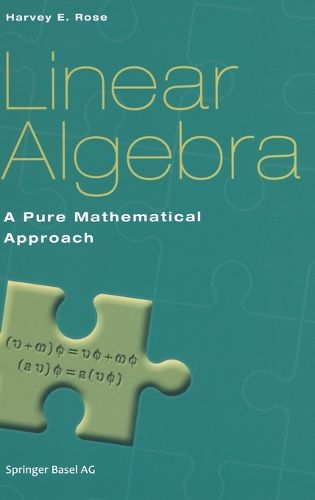Readings Newsletter
Become a Readings Member to make your shopping experience even easier.
Sign in or sign up for free!
You’re not far away from qualifying for FREE standard shipping within Australia
You’ve qualified for FREE standard shipping within Australia
The cart is loading…






Linear algebra is one of the most important branches of mathematics - important because of its many applications to other areas of mathematics, and important because it contains a wealth of ideas and results which are basic to pure mathematics. This book gives an introduction to linear algebra, and develops and proves its fundamental properties and theorems taking a pure mathematical approach - linear algebra contains some fine pure mathematics. Its main topics include: vector spaces and algebras, dimension, linear maps, direct sums, and (briefly) exact sequences; matrices and their connections with linear maps, determinants (properties proved using some elementary group theory), and linear equations; Cayley-Hamilton and Jordan theorems leading to the spectrum of a linear map - this provides a geometric-type description of these maps; Hermitian and inner product spaces introducing some metric properties (distance, perpendicularity etc.) into the theory, also unitary and orthogonal maps and matrices; applications to finite fields, mathematical coding theory, finite matrix groups, the geometry of quadratic forms, quaternions and Cayley numbers, and some basic group representation theory; and, a large number of examples, exercises and problems are provided. It gives answers and/or sketch solutions to all of the problems in an appendix -some of these are theoretical and some numerical, both types are important. No particular computer algebra package is discussed but a number of the exercises are intended to be solved using one of these packages chosen by the reader. The approach is pure-mathematical, and the intended readership is undergraduate mathematicians, also anyone who requires a more than basic understanding of the subject. This book will be most useful for a ‘second course’ in linear algebra, that is for students that have seen some elementary matrix algebra. But as all terms are defined from scratch, this book can be used for a ‘first course’ for more advanced students.
$9.00 standard shipping within Australia
FREE standard shipping within Australia for orders over $100.00
Express & International shipping calculated at checkout
Stock availability can be subject to change without notice. We recommend calling the shop or contacting our online team to check availability of low stock items. Please see our Shopping Online page for more details.
Linear algebra is one of the most important branches of mathematics - important because of its many applications to other areas of mathematics, and important because it contains a wealth of ideas and results which are basic to pure mathematics. This book gives an introduction to linear algebra, and develops and proves its fundamental properties and theorems taking a pure mathematical approach - linear algebra contains some fine pure mathematics. Its main topics include: vector spaces and algebras, dimension, linear maps, direct sums, and (briefly) exact sequences; matrices and their connections with linear maps, determinants (properties proved using some elementary group theory), and linear equations; Cayley-Hamilton and Jordan theorems leading to the spectrum of a linear map - this provides a geometric-type description of these maps; Hermitian and inner product spaces introducing some metric properties (distance, perpendicularity etc.) into the theory, also unitary and orthogonal maps and matrices; applications to finite fields, mathematical coding theory, finite matrix groups, the geometry of quadratic forms, quaternions and Cayley numbers, and some basic group representation theory; and, a large number of examples, exercises and problems are provided. It gives answers and/or sketch solutions to all of the problems in an appendix -some of these are theoretical and some numerical, both types are important. No particular computer algebra package is discussed but a number of the exercises are intended to be solved using one of these packages chosen by the reader. The approach is pure-mathematical, and the intended readership is undergraduate mathematicians, also anyone who requires a more than basic understanding of the subject. This book will be most useful for a ‘second course’ in linear algebra, that is for students that have seen some elementary matrix algebra. But as all terms are defined from scratch, this book can be used for a ‘first course’ for more advanced students.